It seems logical to start with learning A on guitar. It’s arguably not, but since I see this question on line with surprising frequency, let’s talk about it.
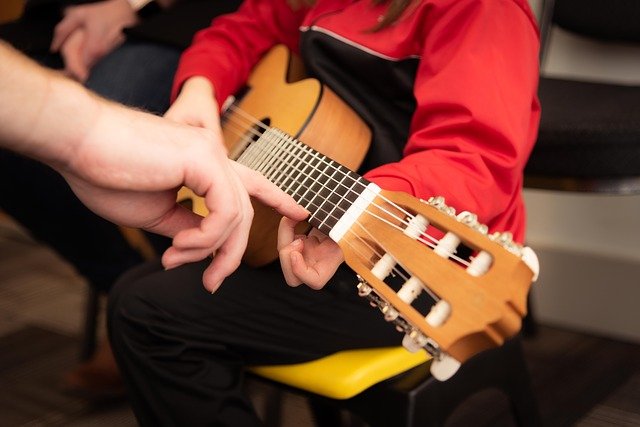
Such an innocent question
I seems like such an innocent question. A new guitar student just wants to know, “How do I play A on guitar?”
And the questioner really expects a simple answer. I understand that. And so, I promise to give a simple answer.
But the question holds deception. That question just requires more than a simple answer to do it justice.
So, for that reason, this article contains not just that simple answer, but a more complete discussion of the question and it’s implications.
Shortcut to the simple answer that you might seek
I have a lot to discuss in order to answer this simple-sounding question. It’s not as simple as it seems.
But I realize you might just want to get to the point of learning how to play the chord A on guitar. If that’s you and you want that simple answer, jump down to the The simple answer you came here for subheading below.
But for those of you who seek more complete understanding, read the following sections in order!
Assumptions
First things first…in order to talk about A on guitar, we have to spell out some assumptions.
Without a few limiting assumptions, the answer to this question might go on forever. Why? Because of the huge number of possible variables in the answer.
Assumption #1: your using a normal six-string guitar
For instance the first thing to consider involves the type of guitar we discuss here. After all, you have six-string guitars, 12-string guitars, and extended range guitars with seven, eight, or more strings. You can play tenor guitars, baritone guitars, and bass guitars. Lap steel guitars count too, and likely some others that I’m not thinking about right now.
Some guitars have more frets than others, and that introduces more possibilities. As you see…it gets complicated.
Therefore, Assumption #1: in this article, you want me to focus exclusively on a “normal” six-string guitar.
Assumption #2: the fretboard repeats itself
Next, to avoid repetition, we have Assumption #2: you know that everything from the open strings up to fret 11 repeats exactly on fret 12 and above. So, for instance, whatever note you find at fret three of the lowest string will also be found at fret 15 of the same string. The same note in different octaves.
Assumption #3: standard tuning
Then, you have to factor in different tunings. So many alternate tunings exist. You can tune your guitar in many, many different and creative ways.
Open G, DADGAD, open D, and on and on. And in each of those tuninings, A sits in different places. That’s confusing—especially to new guitar students.
So, Assumption #3: The guitar we’re talking about uses standard tuning. EADGBE. Most of you will use that tuning most of the time.
Assumption #4: you are in tune
Assumption #4: You know how to tune your guitar to standard tuning. Or, if you don’t, you will happily read my Let’s talk more deeply than just how to tune a guitar article before you continue.
Assumption #5: Both notes and chords
Next, the question does not specify whether you want to know where you can find the note A on guitar or the chord A on guitar. Since I don’t know which you want to learn, I assume you’ll be happy to learn both.
Assumption #5: you want to know how to find both the A note on guitar and the A chord on guitar.
Assumption #6: the major chord
And finally, we have to clarify what you mean by A as it relates to chords. You have the A major chord. Then, A minor. And it goes on to, A augmented, A diminished, A suspended, A seventh, A nine, and it keeps going.
Obviously we’re not going to be able to cover all of that here. Nor is it what you’re actually asking. Therefore, Assumption #6: You want to learn to play a basic A major chord. We have to leave the rest for another time.
And, by the way, that’s not just my assumption. Typically when you hear someone refer to a chord by just its letter name, they’re talking about a major chord. They leave the major off, so it’s implied that they’re talking about A major. From here on in this discussion, that’s what I’ll do too.
Notes: where is A on guitar?
With those assumptions out of the way, let’s get to the topic. First, let’s address the question, “Where is the note A on guitar?”
Unfortunately, if you were seeking a simple, uncomplicated answer, prepare to be disappointed.
See, the guitar provides options. And, yes, those very options present complexity. That’s part of what makes learning the guitar a challenge. But it’s also what makes learning the guitar a fulfilling and joyous life-long quest.
I can show you the note A on guitar, but that only gives you a small piece of the whole picture. That’s because the note A exists all over the guitar.
Charts can cause more harm than good
Here’s a chart that shows you all the A notes on the first 12 frets of the guitar.
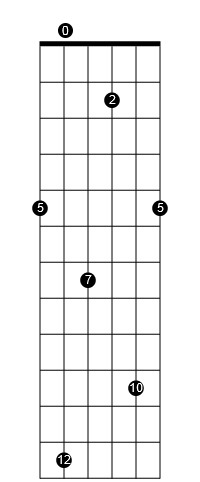
And here’s where so many people falter. You can easily become intimidated when you look at a chart like that. Your brain wants to shut down. It’s overwhelming. I even almost feel guilty including it in this article.
And that’s just the note A. We have 11 other notes. And guess what; they’re all over the place too. If you’ve ever looked at one of those insanely unhelpful charts that list every note on every string on every fret, you know the true desperation of overload.
Such a chart contains so much information that it contains no information. Just a jumbled messy barrier to you learning to play guitar.
So, what should you do?
Teach a man to fish…
What’s the old proverb? Give a man a fish and he eats for a day. Teach a man to fish and he feeds his family forever. Something like that.
It’s the same with learning the notes on guitar. I can sit here and type word after word about where every note exists, but tomorrow you won’t remember but a fraction of it.
Instead, figure out how to find those notes for yourself. I’ve got a few different articles on this site designed to give you practical techniques for finding the notes yourself. Start with Discover the notes on the guitar fretboard everywhere.
Those articles will help you crack the code so you never have to ask anyone where any note is on the guitar ever again. You want satisfaction? That’s satisfaction!
Chords: where is A on guitar?
Now that you know the location of all of the notes A on guitar, let’s turn our attention to the chord A on guitar. Easy enough, right?
Well, not so much. Perhaps it strikes you that if the note A exists all over the guitar, then perhaps the chord A does as well. And, of course, you are exactly right.
So there’s a bunch to talk about here too. First, I’ll give you the easy answer you want. Then I’ll give you a couple more common possibilities. And finally, we’ll geek out on a bit of theory so you can gain some deeper understanding about the question you’ve asked.
The simple A on guitar answer you came here for
OK; all this talk. All these words. You just want to play an A chord and get on with your song, right? Right.
Arguably the most common A chord form—especially for acoustic guitar players—looks like this chart:
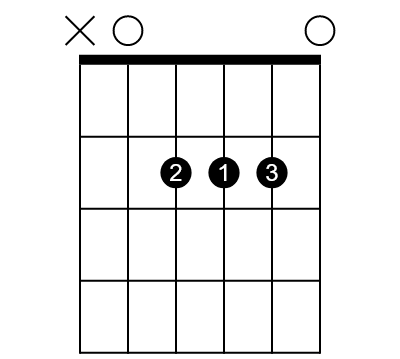
To play it, press the second fret of each the D, G, and B strings.
Notice the fingering I’ve listed in the chart. When you first attempt to play this chord, that’s a bit of a finger twister. But once you become used to it, it’s the most natural, comfortable way to play the chord in my opinion. Some will surely disagree, but I’m right, so…
Still, some players insist on a different fingering where the first and second fingers are swapped.
And still other players play the chord by barring across all three strings with just one finger.
Those alternate methods aside, I suggest you learn the finger-twisting fingering that I showed in the diagram. It isn’t as difficult as it will first seem. And, more importantly, it makes it very easy to switch between the A chord and other chords that commonly come before or after it in many, many songs.
It also helps those of us with a bit fatter fingers to squeeze them all into that second fret. It’s just the right way to do it for a number of reasons.
Rockers’ power chords for A on guitar
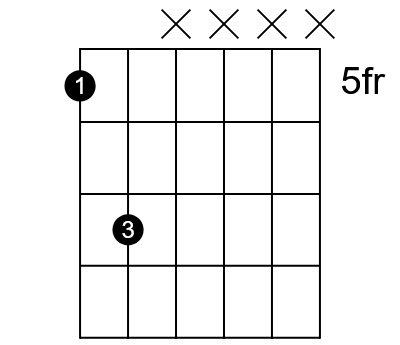
Those of you who want to play heavier music like punk, metal, and so on—particularly on distorted electric guitar—have probably already (or soon will) encounter power chords. So let’s talk about those.
First, technically a power chord isn’t actually a chord at all. A true chord contains three or more notes played simultaneously. A power chord on the other hand, uses just two notes. So technically it’s just two notes in harmony. But many will disagree, so feel free to lash out in the comments if you want to state your case.
And again, more than one possible form exists for the power chord A on guitar. The most common form looks like this diagram.
The fifth fret of the low E string sounds the note A (the root note). One string and two frets up, at the seventh fret of the A string, sounds the fifth degree of the A major scale—the note E. So an A power chord consists of the notes A and E.

You can make the same power chord with the open A and the E note found at the second fret of the D string.
And other possibilities exist too. Like the inverted power chord you can make with the E on fret seven of the A string and the A at fret seven of the D string.
Again, like the A note itself, the A power chord exists all over the neck.
E-shaped bar chord for A on guitar
The final of our three most common A chord shapes brings us to bar chords (I believe that’s barre for our English friends) and the E-shaped moveable chord.
In short (and this warrants a complete article on its own), the shape of the open E chord is one of the most easily—and therefore commonly—moveable shapes on the instrument.
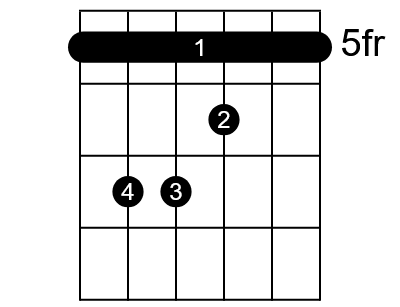
To make an E-shaped A bar chord, bar across all six strings at the fifth fret with your pointer finger. This takes some practice.
Then use your remaining three fingers to create the E chord shape. Use the fingering in this diagram.
Even though you’re playing the E chord shape, because you’re playing it higher on the neck with your first finger bar acting as a moveable nut, the chord becomes an A chord.
Music-theory-nerd answer
Well, all of that is useful information about how to play the chord A on guitar. But it’s still just handing you a fish.
If you really want to be successful at learning the guitar—if you want something that’ll feed you’re learning for life—then let’s talk about how you can figure out the location of all of the A chords everywhere on the neck.
With that knowledge comes power.
How to construct the chord A on guitar
I’ve talked about the construction of a major chord in a couple of different articles. If you need a more detailed discussion, then take a look at It’s easier than you think to learn how to play a chord on guitar.
But I’ll summarize it here. A major chord—any major chord—consists of the first, third, and fifth notes of the major scale.
In the case of the A major scale, those are the notes A, C#, and E. That’s the recipe for an A major chord (remember, I’ll just say A chord, but I mean A major).
So, to put it simply, to find A chords all over the guitar, you just need to find groupings of those three notes.
You already know the location of all the A notes across the neck (from earlier in this article), so the rest should be easy.
In my article A simple pattern can help you learn the notes on a guitar, I give you a fantastic way to quickly work out what notes exist at which frets.
Combine that with the article How to master notes on the guitar fretboard through relationships, and you have a couple of powerful tools that help you identify the 1, 3, and 5 notes that make up any major chord.
Triad A chords everywhere
These three-note shapes of the major chord—called triads—exist all over the neck.
For example, from what we learn in those two articles, you know that we have an A note at fret seven of the D string (as just one example).
You know that the four of the chord is at the same fret one string higher, and the three of the chord is one fret lower than that. Thus you know you have a C# note at fret six of the G string.
And finally, you know the five is the same fret as the one, but on string lower. So you have an E note at fret seven of the A string.
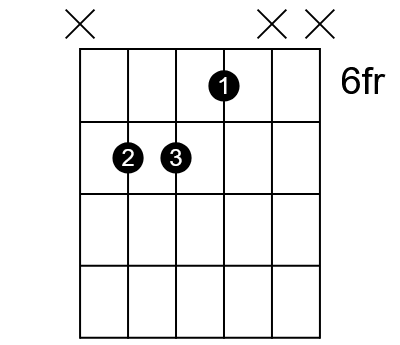
And there you have it. Play fret seven of the A and D strings along with fret six of the G string and you play an A chord.
Use that technique everywhere on the neck that you have an A note and you’ll find many options for playing an A chord.
How come some chords have more than three notes?
It’s true. Earlier I showed two common shapes for the chord A. One contained five notes and the other six. So how does that fit in with what we just talked about regarding triads?
Modified chords with more than three notes
Many chords—in fact, probably most chords—that you’ll play in your career contain more than three notes. When we start modifying the major chord with other notes, we start creating new chords like A seventh, and so on. That’s one main reason many chords go beyond simple triads.
But the chord shapes I showed earlier contain more than the triad foundation, yet still count as major chords. Why?
Repeated notes in a major chord
Remember that note names repeat themselves. So, the note at the open A string is an A note. But at fret 12 of the A string you have another A note. We call both notes A even though they sound different since they are an octave apart.
It’s a quirk of music vernacular, but it’s a necessary quirk. If we didn’t repeat note names, then we’d theoretically have an infinite number of individual names for notes.
Luckily, music is very mathematical. Even though those two A notes exist an octave apart, they have a mathematical relationship. It has to do with sound and frequency, and goes way beyond our discussion here.
Suffice it to say that this mathematical relationship accounts for why these two notes sound different…yet sound the same. They both sound like A notes.
Well, the point is this: when you play those two forms of the A chord I discussed above, you may indeed be playing five or six strings, but some of those strings simply repeat one of the three notes of the basic triad.
So in the open-position A chord I showed first, you have an A on the open A string, an E at fret two of the D string, another A at fret two of the G string, a C# at fret two of the B string, and finally, a second E at the open E string.
Technically, you could add the open low E string too, but that doesn’t usually sound great, so it’s only done in specific circumstances.
Pulling triads out of larger chord shapes
If you have really been paying attention, then you may have noticed that the triad I show in the previous diagram simply pulls three notes out of the larger E-shaped bar chord that I showed in the diagram before that.
Just don’t bar the fifth fret, and then don’t play the Low E, B, or High E strings and you have a perfectly good triad.
It’s a really useful and insightful exercise to extract the notes out of the larger chord shapes to find the triad nugget within.
And the way I show above represents just one triad we could pull out of that larger chord shape. Remember, any combination of the one, three, and five notes of the scale yield a major chord.
For example, you could play just the top three strings of that E-shaped bar chord and have a different A chord.
If you think about it, you begin to see why learning the guitar is a life-long quest. So many possible combinations exist. It never gets boring!
Conclusion
We’ve come a long way and covered a lot of ground. Funny how such a simple question as “How do I play A on guitar” can turn into such a labyrinth of information!
But, after having made certain assumptions, we’ve covered the question from two different angles. First, we now know where all of the A notes on the guitar exist. And second, we know how to find and play all of the possible A major chord shapes on the guitar.
Beyond simply showing where these things exist, we’ve discussed techniques for figuring all this out on your own. And we discussed some resources that can help.
Armed with this information, you can now be the one that tells your band mates and musical collaborators how to play A on guitar!